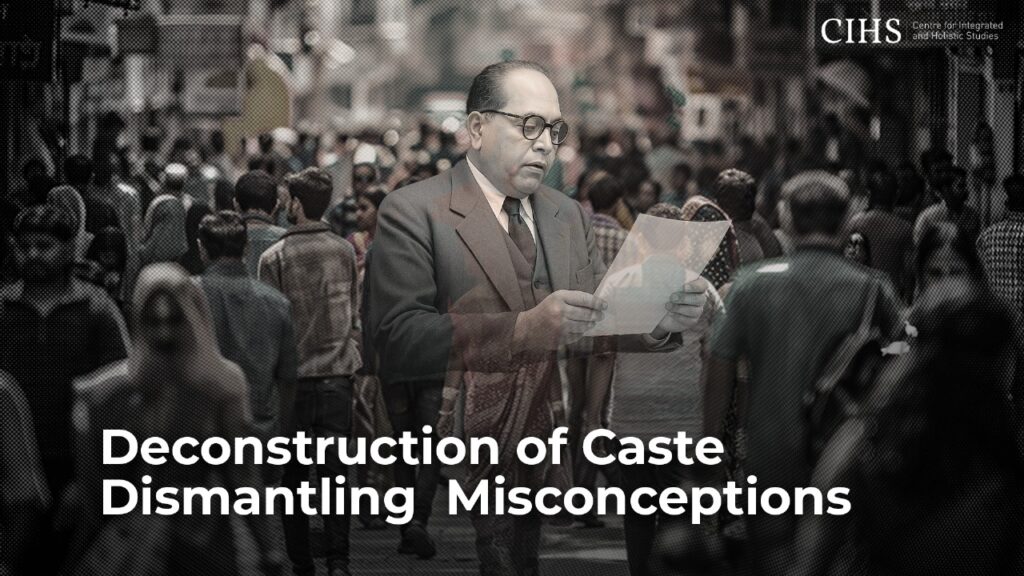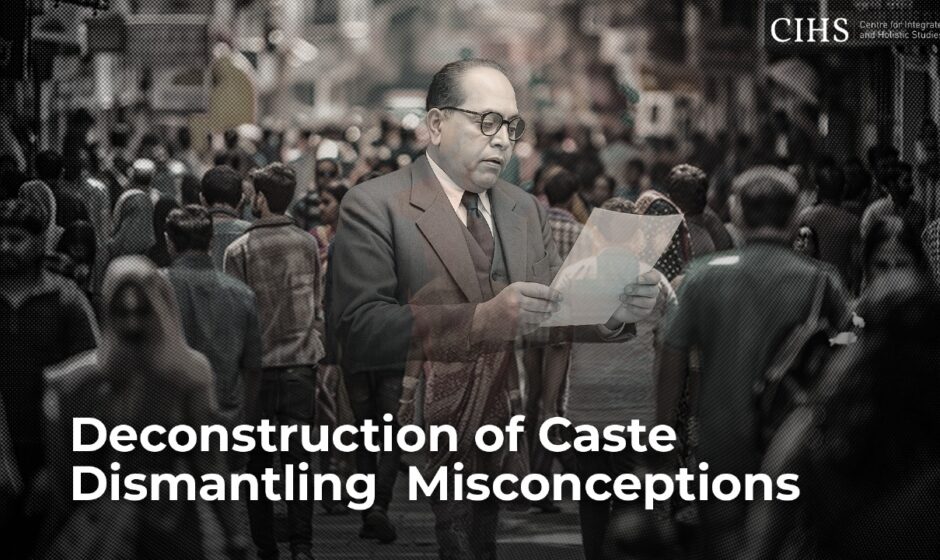Dr Aniket Pingley
Dr. B. R. Ambedkar’s seminal 1916 paper, “Castes in India: Their Mechanism, Genesis and Development,” delivered at Columbia University stands as a profound scholarly effort to dismantle misconceptions about caste.

Rather than accepting popular notions of caste as a divinely sanctioned religious institution or a system imposed nationally by Brahmins, Ambedkar rigorously applied ethnological and sociological tools to uncover its true nature as social technology.
His work, as presented in the white paper, reveals that perpetuation and spread of caste are rooted in distinct mechanisms rather than conscious religious or hierarchical decree.
Challenging Myth of Religious Sanction
Ambedkar fundamentally disagreed with definitions of caste that focused on “surface features” like “food taboos, pollution, occupation, or social exclusivity,” arguing that these “were not essential”.
Instead, in his paper, he asserted, “Endogamy is the only characteristic that is peculiar to caste”. This was a “decisive claim”: caste’s core is not about religion or rituals, but about “regulating marriage” with all other traits being secondary and serving only to “reinforce this boundary”.
To elaborate, Ambedkar began by clearly defining two crucial anthropological terms: exogamy and endogamy. Exogamy refers to the practice of marrying outside one’s own group, a custom that was common in early Indian society, particularly among clans and gotras, and which historically served to expand social bonds.
In contrast, endogamy means marrying within one’s own group, thereby establishing a clear boundary and restricting marital unions exclusively to those inside it.
Ambedkar emphasized that Indian society, despite its diverse ethnic make-up, possessed a fundamental cultural unity and was originally characterized by exogamy as a “creed”. He argued that very creation of caste in India was result of “superposition of endogamy on exogamy”.
This meant that a society that naturally tended towards intermixing and fusion through exogamous practices was artificially fragmented by forceful introduction of endogamy, halting the free circulation of people and creating distinct, closed communities. Thus, for Ambedkar, caste hinges entirely on the rigorous enforcement of endogamy.
“Endogamy is the only characteristic that is peculiar to caste.”
He meticulously demonstrated how the very existence of caste hinges on the rigorous maintenance of endogamy. When a group committed to marrying only within itself, it faced a “demographic logic” problem: “marital balance”. The inevitable presence of “surplus” individuals (widows and widowers) threatened to violate endogamy if they remarried outside the group. To solve this, society developed “means” — social mechanisms to maintain endogamy. Ambedkar identified three primary customs, often mistakenly viewed as religious ideals:
- Sati (Widow Burning): This custom served to “remove the surplus woman permanently”, effectively “preserving caste purity” by eliminating any threat of remarriage.
- Enforced Widowhood: If Sati wasn’t practiced, widows were “required to remain unmarried for life”. Ambedkar explicitly stated this “guards against the evils of remarriage as does burning”.
- Child Marriage (of girls): By marrying girls early, castes ensured “men had secured partners within their group,” preventing “young brides from being claimed by outsiders”. It also “minimized the window of emotional or sexual autonomy”.
Crucially, Ambedkar directly rejected spiritual or philosophical justifications for these customs in his analysis. He argued that these “high-flown and ingenious sophistry” were “invented to justify practices that already existed”.
He powerfully stated, “The very fact that these customs were so highly eulogized proves that they needed eulogy for their prevalence”. He saw them not as expressions of devotion, but as “practical tools” and “strategic adaptations” designed to solve the structural problem of maintaining endogamy.
Thus, Ambedkar exposed how caste operated through “biopolitical control”, where “women’s bodies became the site where caste was enforced,” sacrificing their freedom and survival for the system’s preservation. This demonstrates that caste was preserved by “deliberate enforcement,” not divine will.
No Brahmin Imposition
Ambedkar firmly refuted the widespread belief that caste was “imposed by a divine lawgiver — like Manu” or that Brahmins “consciously imposed caste system on entire Hindu population”.
He stated, “It is unimaginable that the law of caste was given”. He argued that Manu merely “codified” existing caste rules and “preached Caste Dharma,” but “certainly he did not and could not ordain the present order of Hindu Society”.
Similarly, while acknowledging Brahmins “became the first caste” by “socially detach[ing] themselves” and creating a “closed-door policy”, he explicitly stated that “imposing of caste system on non-Brahmin population was beyond their mettle”. They “may have helped the process by their glib philosophy, but they certainly could not have pushed their scheme beyond their own confines”. The “spread and growth of the Caste system is too gigantic a task to be achieved by the power or cunning of an individual or of a class”.
“The Brahmins may have been guilty of many things, and I dare say they were, but the imposing of the caste system on the non-Brahmin population was beyond their mettle”.
Instead, Ambedkar proposed two “powerful explanations” for the multiplication and spread of caste across India, which he called a “psychological process” (imitation) and a “mechanical process” (exclusion):
- Imitation (Psychological Explanation): As the Brahmins gained “prestige” by enclosing themselves through endogamy, other groups began to “imitate their behaviour”. Citing Gabriel Tarde, Ambedkar highlighted that “imitation flows from the higher to the lower”. Endogamy, along with its supporting customs like child marriage and enforced widowhood, became a “status symbol” that groups adopted to “elevate or preserve their status”. The “infection of imitation… caught all these sub-divisions… and turned them into castes”.
- Exclusion (Mechanical Explanation): This process describes how groups were “forced to become castes themselves” due to circumstances. If individuals or groups “broke caste rules” (e.g., through intermarriage or adopting new customs), they were “excommunicated”.
- Since “every caste was enclosed,” these outcast groups “could not join another” and were thus compelled to form their own new, “closed communities”. This created a “fissiparous” nature of caste, where “every innovation, every deviation, every exclusion — created another endogamous unit”. It was a “mechanical law” by which groups were “constantly being converted into castes to a bewildering multiplicity”.
“The infection of imitation… caught all these sub-divisions… and turned them into castes.”
These two forces — “Prestige-seeking imitation” and “mechanical social closure” — explain how caste spread and solidified into a complex system without a single, deliberate imposition or divine command.
In essence, Ambedkar’s white paper revealed that caste is not a sacred mandate or a grand Brahminical conspiracy, but rather a “social system governed by status, hierarchy, and control over marriage”. It is a “parcelling of an already homogeneous unit” of Indian society into thousands of endogamous units. He offered a scientific framework, urging that to truly dismantle caste, one must first grasp its “mechanisms”: “How it begins, How it survives, And how it spreads”.
Ambedkar’s analysis, as laid out in his paper, can be likened to a forensic investigation: rather than accepting hearsay or superficial religious narratives, he meticulously examined the societal “crime scene” of caste. By tracing the “fingerprints” of endogamy and its “tools” (sati, widowhood, child marriage), he demonstrated the systemic and structural nature of the “offense,” revealing it as a deliberate social construct, not an act of divine or centralized authority.
(Author is an accomplished computer scientist, educator, and holds expertise in media content strategy)



